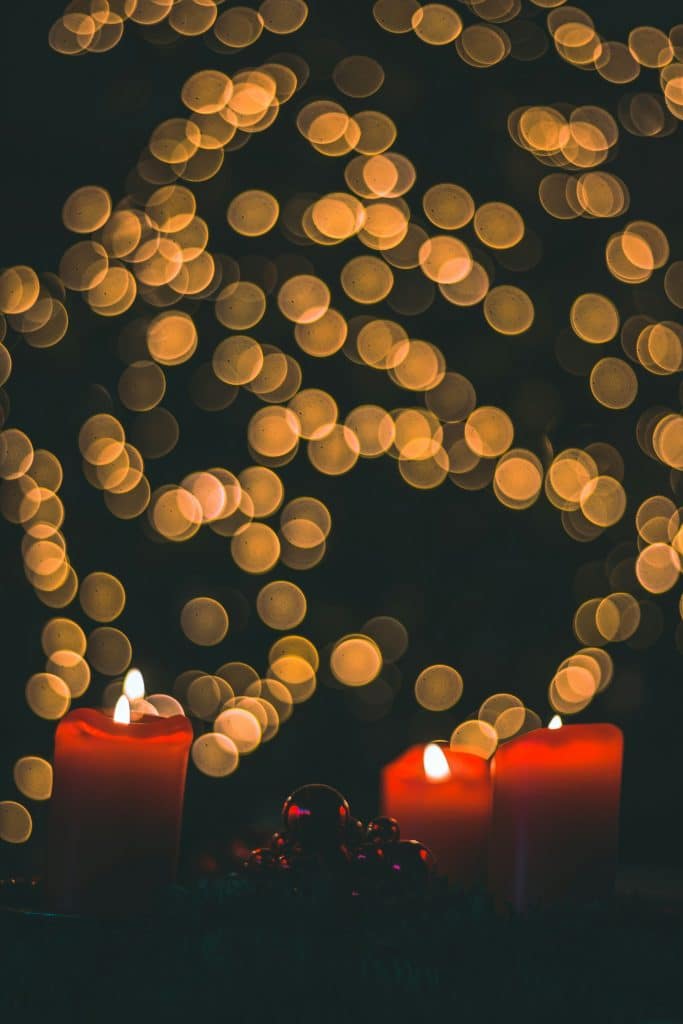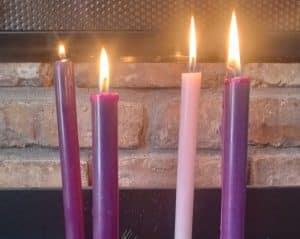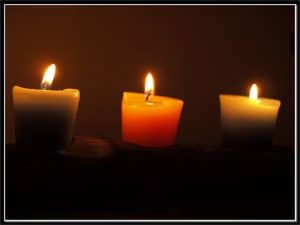Guest post by Rachel Hunt Steenblik, who is a co-https://exponentii.org/wp-content/uploads/2021/12/IMG_5173-scaled-1.jpg of Mormon Feminism: Essential Writings and the author of Mother’s Milk: Poems in Search of Heavenly Mother and I Gave Her a Name.
From a talk given Sunday, December 10, in the Columbus, IN 2nd Ward

Good morning, brothers and sisters.
One of my favorite parts of Christmas, is the traditions, and how they differ slightly between families, religions, cultures, and countries, while having commonality threaded between them of family togetherness, memory, and love.
One of the traditions we’ve been doing in our home this year is two different versions of Advent, counting down the days until Christmas.
One of these is a children’s book advent, made up of many books we already owned, and a few new ones we didn’t. (We also do a mix of Christmas, Solstice, and Chinese New Year’s books to honor other parts of our family culture.) Each one is wrapped, and each day, going in order from oldest to youngest, one of my children gets to choose a book to unwrap and we read it together.
The second is a Harry Potter Lego advent calendar gifted from my mom. The idea is the same, but in opposite order. So if it’s our oldest child’s turn to open a book, it is our youngest child’s turn to open a Lego. Each day my kids ask me whose turn it is and when they can open them. They’re excited for this tradition helping them wait.
There is another version of Advent, that instead of counting down the days before Christmas, counts down the weeks, specifically the Sundays, starting four Sundays before.
I was introduced to this tradition when I was at BYU. My friend’s roommate, Annika, was from Germany and was far from home and family, so she invited friends and acquaintances to celebrate this important tradition with her. Every Sunday many college students squeezed together in a small college student home, to light candles set in a flat evergreen wreath, laying on a table, first one candle, then two, then three, then four, on the last Sunday.
As we gathered there, Annika would tell us about what each candle represented and share a small thought on the theme. The first one was hope, the second was peace, the third was joy, the fourth was love. They also had names. Hope was the Prophecy Candle. Peace was the Bethlehem Candle. Joy was the Shepherd’s Candle. And love was the Angel’s Candle.
Three were purple to represent penance and prayer in the traditional liturgy, but joy was pink, because rose was joy’s liturgical color. We sang Christmas songs, ate German cookies, and talked.
In a First Presidency Christmas Devotional several years ago, President Dieter F. Uchtdorf spoke of celebrating this same tradition as a young boy. He shared:
“When I was very young and living in East Germany, Christmas in our family began four weeks before Christmas Eve with the beginning of Advent. We made a fresh-cut wreath from a fir or a spruce and put four candles on top of it and placed it on our kitchen table. On the fourth Sunday before Christmas, we lit the first candle.”
Uchtdorf said that they also “sang Christmas songs and listened to Christmas stories…” and added, “Advent was a time of anticipation and hope and it brought a special feeling into our humble home as we prepared for something holy and beautiful. Each Sunday we lit one additional candle, by the fourth Sunday our expectations for the coming joyous events had reached their peak.” (Dieter F., Uctdorf, First Presidency’s Christmas Devotional, December 2008)
A BYU Religion Professor named Eric Huntsman, who is currently the academic director of BYU’s Jerusalem Center, has written extensively about his own experiences incorporating this tradition into his family’s celebrations of Christmas.
In one of these, he shared that the word “[Advent] takes its name from the Latin term adventus, which means ‘coming’ or ‘appearance,’ and that he remembers when his daughter Rachel was five, and “how much he enjoyed explaining to her the symbolism of the small wreath that [they] had purchased, describing how the wreath represents the never-ending circle of God’s love, showing that he is the same forever in his love toward his people. The green of the wreath, as in the Christmas tree, represents the hope of eternal life that comes through Christ and serves as a reminder of the freshness of God’s love and promises. The light of the candles reminds us that Jesus is the Light of the World, that his birth represented the coming of that light into darkness, and that we are called to reflect that light in our lives.” (Eric D. Huntsman, “Good Tidings of Great Joy: Celebrating Advent,” Wayfare Magazine, Nov. 25, 2023.)
At its heart, Advent is also about waiting and acknowledging that the thing we are waiting for is not yet.
A German theologian I admire, named Dietrick Bonhoeffer, was imprisoned during World War II for his resistance to the Nazis. While he was in prison, waiting in more than one way, he wrote: “Celebrating Advent means being able to wait. Waiting is an art that our impatient age has forgotten. …Whoever does not know the austere blessedness of wafting–that is, of hopefully doing without–will never experience the full blessing of fulfillment. … For the greatest, most profound, tenderest things in the world, we must wait. It happens not here in a storm but according to the divine laws of sprouting, growing, and becoming.” (God Is in the Manger: Reflections on Advent and Christmas, p 4, Presbyterian Publishing Corporation. Kindle Edition.)
An LDS writer, I admire, Cece Proffit wrote, “The gift Advent offers me in this season of my life is the space to acknowledge that all is not yet as it should be. … Advent doesn’t ask me to pretend that all is well when I know with perfect clarity that it is not. Advent invites me instead to lean into my longing for a better world, and to allow that longing to move me towards hope.” (Cecilia Proffit, “Come, Lord Jesus: An Advent Invitation,” Wayfare Magazine, Nov. 25, 2023.)
When an angel brought the shepherds “good tidings of great joy” and said with an added “heavenly host” “and on earth peace, good will toward men,” (Luke 2:10; Luke 2:13-14) there wasn’t peace on earth. Not yet. At least not the kind many in the world were expecting. There was political turmoil and danger for many. As we celebrate Christmas this and maybe every other year, there is not peace on earth. Not yet. Not in the ways we might want. Instead, there are wars and rumors of wars. And still we remember and reenact the angels words, about peace. And still we hold up light, and try to create more light.
I’m also thinking about these various types of Advent for a few additional reasons.
The first is because waiting is often uncomfortable. It’s hard. Most of us don’t like waiting. Even Dr. Seuss in his book, “Oh the Places You’ll Go” describes the waiting place as a place you want to get out of.
But waiting also gives us the opportunity to exercise faith, hope, and charity.
And in our lives, we will all be asked to wait upon the Lord for things that we cannot see, for things that we may desperately want and hope for. For some, that might be a partner to go through life with. For others, a child; or a good job; or to do well on a test, or in a music or sports performance. We may be waiting for greater health for a loved one, or resolution to another issue close to our heart.
The second reason Advent is on my mind is from thinking about the first Christmas. We can count down a set number of days or Sundays towards a specific date, because we know the date we will celebrate Christmas. But Mary and Joseph could not do this. They did not know the date Jesus would be born, that first Christmas. Neither did the wisemen. Neither did the shepherds. Maybe only the angels.
Even more, while I hope and trust Mary was supported by midwives during her pregnancy and potentially birth, she and Joseph did not have OBGYN appointments or ultrasounds to help them estimate the due date. It might have just been a “due season,” so they experienced fresh waiting, expecting, hoping, and more waiting—so much waiting.
For our births and pregnancies, those of us in modern times will be given an expected “Due Date” to count down to, even knowing that it’s unlikely our baby will be born on that actual day. I suspect many mothers can remember their children’s due dates in addition to their actual birthdates. For example, my daughter was due October 5th. She was born October 10. My oldest son was due April 30th. He was born May 9th. My last baby was born over two weeks late, in a Chinese hospital during the pandemic. I ultimately had to be induced. Even then, when I knew what date he was likely to be born, there was waiting. By myself, my husband, the many doctors and nurses surrounding me, and my doula.
I shared I hope that Mary was supported by midwives, and love modern day paintings depicting that. I hope Heavenly Mother was waiting with her, too.
The closer you get to your due date, the more intense the waiting can feel. Especially at the very end of pregnancy, when, if you’re lucky, the nausea has abated, but the discomfort, difficulty sleeping, and need to go to the bathroom a whole lot remains. When the internal kicks are both comforting, because they tell you the baby is alive and well, but also painful because the baby has grown. When you’re really, really, really ready for that sweet baby to be out of your body and in your arms, to see their face.
When, towards your due date, every time you call a family member or friend about anything else, they wonder if you’re in labor, and you have to tell them for what feels like the umpteenth time, that you’re not.
And you might also be feeling anxious or scared about the birth. Especially if it’s your first birth, you might be wondering what labor will feel like, and if you’ll be able to recognize it. You may wonder when to go to the hospital or when to call your midwife, doula, or mom. You may wonder, hoping, that everything will go well, and that you’ll be strong enough to carry you and your baby through what is needed. To even in that time, wait.
Mary may have been feeling many of these same things. I think it’s important to remember this. I think the physicality of birth and waiting, especially by a woman matters. Because Jesus, like us, needed a body, and a woman’s body, courage, and love, is how it happened.
I hope you’ll think about some of this, as you wait, expectantly for Christmas, and as you light candles, or trees, thinking about Jesus who IS the light, and that we can intentionally practice hope, peace, joy, and love.
In the name of Jesus Christ, amen.
***
With gratitude to Cece Profitt who pointed me toward beautiful articles and quotations and helped me think through these topics.






One Response
This is so beautiful, Rachel. Thank you for sharing!